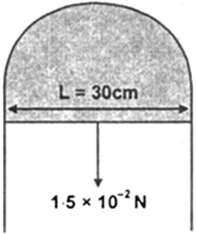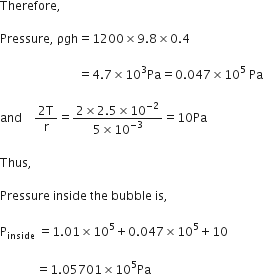
Therefore, total length of free surface that touches with slider is 2L = 60cm = 0.60 m.
Because the slider can support 1.5x10–2N weight.


Here,
Angle of contact,
Radius of the narrow tube, r = 1.0mm=10-3m
Surface tension, T = 0.465 N/m
Density of mercury, = 13600 kg/m3
We know the height by which liquid rises in the tube is,
Negative sign means that mercury will dip down.
If an air bubble of 5.0 mm is formed at depth of 40.0 cm inside a container containing soap solution (of relative density 1.20), what would be the pressure inside the bubble?(1AP = 1.013 x105 Pa and surface tension of soap solution is 0-025 N/m)

 =1.2 gm/cc = 1200 kg/m3
=1.2 gm/cc = 1200 kg/m3 
